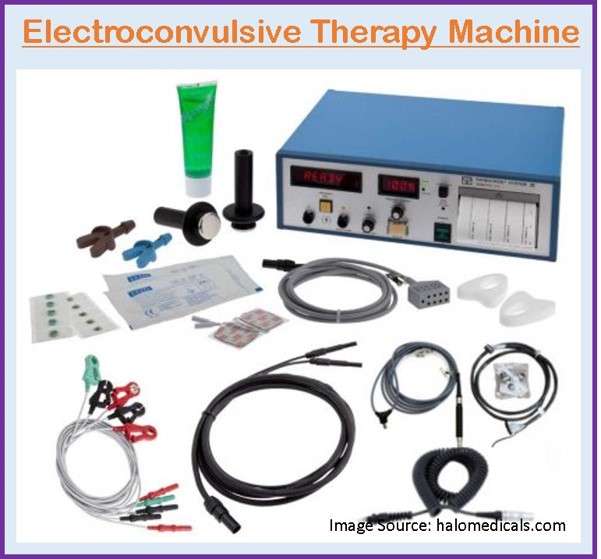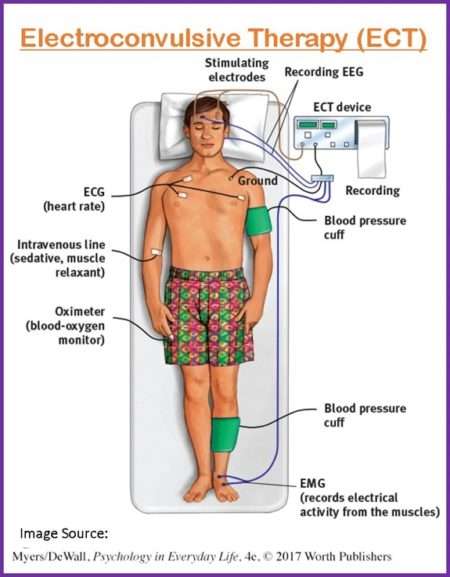Introduction
Electroconvulsive Therapy (ECT) is the procedure in which electrical stimulation of the brain is done to produce seizures for therapeutic purposes.
- ECT induces controlled seizures in the patient by placing small electrodes at specific locations on the head.
- Two sets of electrodes are placed on the scalp: one to monitor brain activity and another to deliver electric current.
- This seizure is effective in controlling psychiatric symptoms.
Types of Electroconvulsive Therapy
Bilateral ECT: The electrodes affect the entire brain and are positioned on both the left and right sides of the head.
Unilateral ECT: In this case, one electrode is positioned on top of the head and the other on a temple, typically on the right. The current only moves through one side of the brain in this instance.
The right unilateral ultra-brief pulse, which lasts less than half a millisecond as opposed to the standard one-millisecond pulse, allows for fewer memory issues with the treatment in newer ECT techniques.
Indications of Electroconvulsive Therapy
- Patients with treatment-resistant depression (unresponsive to multiple antidepressant medication trials) or severe major depression.
- As a treatment for suicidal ideation, severe psychosis, food refusal secondary to depression, and catatonia.
- Bipolar depressive and manic patients
- Safer in debilitated, elderly, pregnant, and breastfeeding patients than antidepressants or antipsychotics.
- Patients that have shown a positive response to ECT previously.
Contraindications of Electroconvulsive Therapy
Absolute
- Elevated intracranial pressure with mass effect
- Pheochromocytoma
Relative
- Elevated intracranial pressure without mass effect
- Stroke
- Severe hypertension
- Cardiovascular conduction defects
- High-risk pregnancies
- Aortic and cerebral aneurysms
Note: Seizures induced by ECT may cause a temporary rise in blood pressure, heart rate, myocardial oxygen consumption, and intracranial pressure. Thus, precautions are necessary for patients with cardiovascular, respiratory, or central nervous system compromise.
Procedure of Electroconvulsive Therapy

Equipment required
- Intravenous cannula (different sizes)
- Non-invasive arterial blood pressure (NIBP), pulse-oximeter, and three-lead electrocardiography (ECG)
- Devices for management of the airway:
- Oropharyngeal and nasopharyngeal airways
- Laryngeal mask airways
- Endotracheal tubes
- Laryngoscope with blades
- Flexible bougie
- Lubricants
- Suction accessories
- Mouth guards
- Oxygen face-masks
- Gauzes, dressings, and adhesive tapes
Duration of treatment
- The number of required sessions depends on the symptoms of the patient.
- Over several weeks, many people attend six to twelve sessions every two to five days, which are frequently tapered off over time.
- The Maintenance dose is given once a month to decrease the relapse rate of the client with recurrent depression.
Preparation before the Procedure
- Complete medical history and examination regarding cardiovascular, pulmonary, neurological, and musculoskeletal systems
- Complete psychiatric history and examination
- Documentation of results of medication trials (especially dose and duration)
- An indication of hand dominance
- A history of dental issues and examination for missing or loose teeth
- Cognitive assessment
- Common tests
- Complete blood count
- Serum chemistry
- Renal function
- Electrocardiogram
- Urinalysis
- Chest X-ray of patients with cardiovascular, pulmonary disease or a history of smoking
- Brain imaging (CT or MRI)
- Electroencephalogram
- Neuro-radiological and neuropsychological tests
- Spinal radiograph of patients with known or suspected spinal disease
- Teach family and patients about the procedure and obtain informed Consent.
- NPO from midnight or at least 4 hours
- Take baseline vital signs, hairpins, contact lenses, dentures, etc.
- Remove fingernail polish
- Open IV line
- Administer short-acting anesthetic
- Administration of a sedative or muscle relaxant (succinylcholine)
- Additionally, atropine is given to reduce bronchial secretions, which could clog the airways during attacks.
- Instruct the patient to urinate prior to the procedure.
Care during the Procedure
- Monitor blood pressure, pulse, respiration, and oxygen saturation
- Insert Intravenous line
- Provide medications:
- Short-acting anesthetic agent and muscle relaxant if not given previously
- 100% oxygen by mask via positive pressure
- A Bite block is placed to prevent tongue bite
- Either place electrodes on one side of the client’s head (unilateral) or both sides (bilateral).
- Utilizing an electroencephalogram (EEG) to monitor the brain.
- Give electrical stimulus (seizure should last 30 to 60 seconds).
Care after the Procedure
- Place the patient in the side-lying position and clean the secretions.
- Reorient the client when s/he is awake and provide reassurance because they may be confused or disoriented for several hours.
- Obtain and record vital signs every 15 min for 30 min and once every 30 min till the patient recovers to the normal stage.
- Allow the patient to sleep for 30 min to one hour.
- Assess the client for the return of the gag reflex
- If the gag reflex is positive, feeding is allowed.
Benefits of ECT
ECT is beneficial in those patients when:
- Rapid treatment response is needed in pregnancy, in case of suicidal, or homicidal patients.
- Postpartum psychosis and severe depression in pregnant and nursing people (also reducesthe risks associated with medication exposure to the fetus or breastfeeding infant).
- The patient avoids eating, resulting in nutritional deficiencies.
- There is resistance to antidepressant therapy.
- Other medical problems that prevent the use of antidepressants.
- The patient has catatonic stupor and marked psychomotor retardation.
- Extreme agitation.
- There is depression with psychotic features.
- There is bipolar disorder including both psychotic mania and depression.
- There is a severe risk of suicide.
- Patients have had a positive previous response to ECT.
- Patients have major depression and schizophrenia.
- The Patient has depression related to Parkinson’s disease as well as a neuroleptic malignant syndrome and intractable seizure disorders.
Risks of ECT
Bilateral or bi-temporal ECT causes more cognitive impairment than unilateral ECT.
Immediate effects of ECT may include:
- Loss of memory about the events immediately before and after ECT
- Heart rhythm disturbances
- Low blood pressure
- Headaches
- Nausea
- Sore muscles
- Aching jaw
- Confusion
Generally, these symptoms resolve within a few hours, but some memory loss may persist.
Summary
- Electro-Convulsive Therapy (ECT) is the procedure in which electrical stimulation of the brain is done to produce seizures for therapeutic purposes.
- ECT is indicated for patients with catatonia, bipolar disorder, major depressive disorder, schizophrenia, and other mental disorders.
- Absolute contraindication for ECT is elevated intracranial pressure with the mass effect and Pheochromocytoma.
- The frequency and duration of the treatment sessions vary according to the patient’s symptoms.
- Side effects are usually temporary including loss of memory about the events immediately before and after ECT heart rhythm disturbances, low blood pressure, headaches, nausea, etc.
References
- Mandal, G.N. (2012). Textbook of Adult Nursing. Makalu Publication House, Kathmandu
- Sharma, M. et. al. (2020). Comprehensive Textbook of Medical Surgical Nursing. Samikshya Publication, Kathmandu
- Silvestri L.A., & Silvestri, A. (2022) Comprehensive Review for the NCLEX-RN Examination. Saunders
- Espinoza, R. T., & Kellner, C. H. (2022. Feb 22). Electroconvulsive Therapy. The New England journal of medicine, 386(7), 667–672. https://doi.org/10.1056/NEJMra2034954
- Cherry, K. (2021, Sep 17). What is Electroconvulsive Therapy (ECT). Verywellmind. Retrieved 2023, Jan 16 from https://www.verywellmind.com/electroconvulsive-therapy-2795172
- Mankad, V.M. (2019, Sep 24). Electroconvulsive Therapy. Medscape. Retrieved 2023, Jan 16 from https://emedicine.medscape.com/article/1525957
- RNpedia. (n.d.). Electroconvulsive Therapy (ECT). Retrieved 2023, Jan 15 from https://www.rnpedia.com/nursing-notes/psychiatric-nursing-notes/electroconvulsive-therapy-ect

